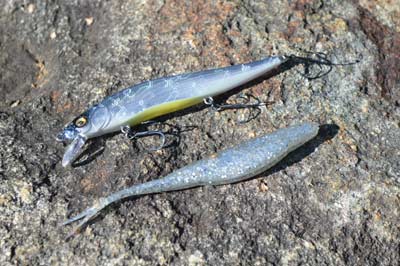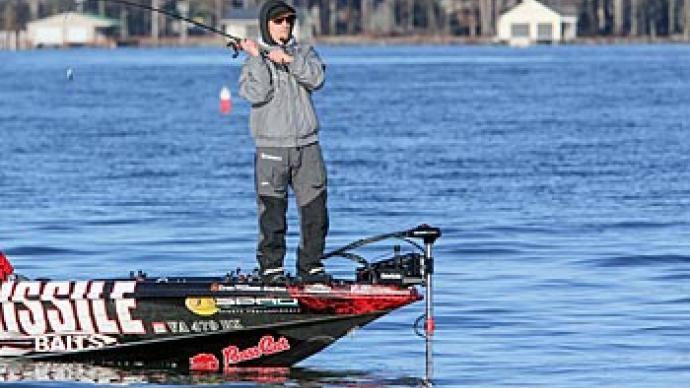
Clear water is a double-edged sword. You can see the cover, baitfish, and other clues that point to where bass live. But the bass can see you just as easily, whether that's your shadow, boat, or lure. So while it may make you more confident, it makes them more cautious.
There are ways to coax strikes from more of these skittish bass. Holding your boat further away from spots, reducing the chance of alerting bass to your presence, is one. Making sure you’re casting into the sun is one more. But the most important is selecting appropriate lures.
Lures attract, entice and hook bass through various means, including action, size, speed, and color. Loud and gaudy combinations accomplish those tasks in muddy water. But the opposite does better in clear water, where bass can see further, in addition to sensing lures with their lateral lines. The best lures for clear water look natural, blend into the background and even confuse bass.
While plenty of lures produce in clear water, these five are the go-to options. They perform best in this fishing condition, which you can find year-round. Even reservoirs filled with stained to muddy water in spring, for example, can clear in fall after rainfall tapers off during summer.
Translucent Topwaters
Topwater lures are a natural choice in clear water. Producing a subtle action and riding high above any cover, they're easy to spot so that bass will travel — horizontally or vertically — to bite one. At home in shallow water, they also draw bass from extreme depths. Smallmouth will rocket through 20 feet or more of clear water for one.
While bass in clear water will bite any topwater, you’ll get more strikes if yours is translucent or transparent. They have all the attractive action of ones sporting flashy paint jobs but only a fraction of their silhouette. So, bass have to bite them to decide if they’re food or not. And when they do, set the hook.
Don’t confuse translucent and colorless. They’re similar but not the same. Colorless lures lack any color. Their bodies are transparent like a window or tap water. Translucent lures allow light to pass through. While many have a colorless belly, their backs are often translucent green, for example, sides can be translucent pink, brown, chartreuse, or other colors. When worked across the surface, they can be difficult for bass to see, but they bring a flash of color, which can entice bass on overcast days.
Throw your clear or translucent topwaters on a long rod, at least 7 feet in length. That will launch it further from your boat or bank, where wary bass are more likely to strike. Choose a moderate-fast action rod. The flex in the tip will make the pops and twitches needed to bring your lure to life more effortless. Fill your high-speed baitcasting reel with a clear or green monofilament line, which disappears in clear water. And unlike fluorocarbon line, it floats, keeping your topwater riding high.
Weightless Worms
Many lures have made a splash with anglers. But few, if any, have made a bigger one than stick worms such as Yamamoto’s Senko. Bass, wherever they swim, find them irresistible, thanks to a slender shape, natural colors, and a slow fall that produces just enough wiggling action when rigged without weight. Those traits are everything you need when fishing clear water.
There are two rigging choices for fishing stick worms in clear water, and the amount of cover dictates which one you use. Wacky style — hook runs once through the center of the bait — is the most popular. With both ends free to move, it creates twice the action and slows the fall. It also skips across the surface easily, an important consideration when you must reach bass tucked far under docks and overhanging cover such as shoreline trees.
The second option is a Texas rig worm threaded onto the hook, so the eye and point are protected. While it produces less action than wacky rigging because the hook anchors one end of the worm, it still creates a slow fall. On the other hand, it's extremely difficult to snag, so it’s a good choice for fishing around laydowns or thick beds of emergent or submerged aquatic vegetation.
Both rigging options share a common trait: They lack a weight. That slows the fall, giving bass who can see your offering from further away the chance to swim over and eat it. And it makes it look more natural, encouraging bass to eat it once they arrive.
Rig your stick worm on a baitcasting or spinning outfit with a medium-heavy or heavy power rod and fast action. Spool the respective reel with braided line, 15- to 30-pound test. It packs plenty of punch in a thin diameter. It’s more flexible, too, allowing your lure to create more action.
Slim Stickbaits
Long and slender, jerkbaits are often said to have the most natural profile. And their slashing action, created by snaps, pulls and pauses, draw bass from long distances. That’s why they are the classic choice for fishing clear water.

Jerkbaits are divided into two categories — hard and soft. Hard-plastic jerkbaits have been an essential part of every well-equipped bass angler's arsenal for decades. Outfitted with a diving lip and two or three treble hooks, they produce plenty of action and sound. Use them during low-light conditions, such as when the wind ruffles the water's surface. While they work best when the water temperature is in the 50s or colder, they take their fair share of smallmouth from warmer water.
You have an option if the conditions seem too calm and clear for a hard jerkbait. Soft-plastic jerkbaits, such as Zoom’s Super Fluke, retain the hard jerkbait’s action but create only a fraction of its noise, thanks to a lack of rattles and hanging hooks. They also can be fished around and through thicker cover because of their Texas rigging. In addition, a small bullet weight — no more than 1/16 ounce — pegged on the line ahead of your bait will help it reach deeper depths and create more action.
The most-popular jerkbaits, hard or soft, measure 4-and-a-half inches or shorter. That makes them relatively lightweight, so fish them on spinning or baitcasting rods with a medium or medium-heavy power. The latter is needed to set hooks hidden in a Texas rig. A fast tip will create more action. Braided line 20-pound test or less or 8- to 15-pound test fluorocarbon line will handle most situations.
Speedy Spinnerbaits
A lifelike silhouette is one way to make your lure more appealing to bass swimming in clear water. Speed works, too. Reel a lure fast enough, and bass won’t have time to inspect it. Eat it now, or lose it forever.
Few lures react better to speed than spinnerbaits. While their pulsating skirt and thumping blade or blades may seem out of place in clear water at rest or while slowly retrieved, they become more comfortable the faster you move them. Of course, some spinnerbaits do that better than others.
Start with the blades. Round Colorado blades, for example, create a strong thump, which bass can sense in dirty water. But they create resistance, slowing retrieves. It’s the same deal with the slightly more elongated Indiana blades. So, switch to willow-leaf blades, no larger than size No. 4.5. They slip through the water with the least resistance and create the most flash. That attracts bass from greater distances in clear water.
You’ll need a slightly heavier spinnerbait — ½ ounce at least — to create balance at faster retrieve speeds. In addition, it's a good idea to add a soft-plastic trailer, which will act like a keel, and a trailer hook, which will make hooking bass that swipe at your spinnerbait more likely.
Even with a heavier head, this spinnerbait will rise in the water column when retrieved quickly. And that's OK. Running it slightly below the surface — no more than a couple of feet deep — will help camouflage it. A white or translucent skirt and silver blades will almost disappear against the sky on sunny days.
There’s no need to skimp on tackle for this presentation. The lures are relatively heavy, and the strikes are incredibly violent. Baitcasting rods with a fast action and heavy power matched to high-speed reels spooled with 15- or 17-pound test fluorocarbon line will treat you well. You'll spend much time with the rod's butt braced against your side or under your arm, so consider one with a full rear grip. It’ll be more comfortable than a split grip.
Junior-Sized Jigs
Jigs are the most versatile bass lure. While traditional sized ones will work, smaller finesses ones do better in clear water. Subtle and closer in size to actual prey, they are like little meatballs that bass easily snarf up.

Finesse-sized jigs typically weigh 3/16 or ¼ ounce, though ones with heads made of tungsten pack more weight without adding bulk. They sport the typical silicone skirts in various colors, including natural hues like watermelon and pumpkin, that work best in clear water. Always add a soft-plastic trailer to your jig. Smaller is better in clear water. It’s needed to make your jig’s profile more natural, so lean toward ones with pinchers or flat appendages. And forgo rattles. They’re not needed.
Small silicone-skirted jigs aren’t the only option. Hair jigs are considered finesse, too. While not tied with traditional bucktail, marabou jigs, which are tied with turkey feathers, are favored when chasing big smallmouth in shallow crystal-clear water. The natural material breathes in the water, rippling as it's reeled. So, steady retrieves rule.
You'll need a spinning rod — 7 feet long with a moderate action and medium power — to get the most out of a marabou jig. Spool its reel with 6- or 8-pound test braided line, which will aid in casting distance and lure action. You'll need something beefier for the silicone-skirted jig, but don't go overboard. A 7-foot-long medium-heavy baitcasting rod with a fast action matched to a high-speed reel spooled with 20-pound test braid or 12- or 14-pound test fluorocarbon will present these jigs to docks, rocks, laydowns, and any other bass-holding cover you see in clear water.
BassResource may receive a portion of revenues if you make a purchase using a link above.




